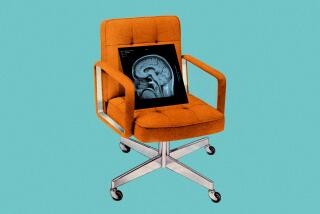They had their heads examined
- Share via
Armed with a caliper and a ceramic head, a 19th century phrenologist could supposedly distinguish a homebody from a wanderer, a generous man from a miser and a math whiz from a dunce. Such “doctors” had a large following in Europe and the U.S. more than a century ago.
---
At the turn of the 19th century, Austrian physician Franz Joseph Gall proposed that the brain was divided into organs, or segments, each corresponding to a different personality trait -- and that the size and shape of different brain parts matched a person’s character.
Such traits would leave their mark on the outside of the skull, he proposed. An organ would grow larger as it was used, generating a measurable bump on the skull, or grow smaller if unused, causing cavities or depressions in the skull.
Gall called his study organology; he was, after all, identifying organs of the brain. It was his follower-turned-collaborator, Dr. Johann Kaspar Spurzheim, who dubbed the practice phrenology ( “study of the mind”) and took it on the road in Europe and the U.S.
Spurzheim and others developed Gall’s ideas even further, identifying 35 brain “organs” (also called faculties) that reflected such innate characteristics as parental love, acquisitiveness, individuality, combativeness, friendship, mirthfulness, secretiveness, self-esteem, hope, calculation and “alimentiveness” (or love of food). Bumps, bulges and divots on the brow, forehead, back, top and sides of the head could even reveal whether one was likely to be patriotic or to hate one’s own children.
Phrenology, the practitioners said, revealed the path to self-improvement.
Perhaps no one touted that last idea louder than the two Fowler brothers, farmers’ sons from New York. Beginning in the 1830s, Lorenzo and Owen Fowler, barely college graduates, popularized phrenology across the U.S. Their Lower Manhattan museum, the Phrenology Cabinet, contained scores of skulls and head-casts, including ones of criminals and “the most distinguished men that ever lived.” It was nearly as big a draw as P.T. Barnum’s nearby circus.
The brothers also published tomes and journals on the topic, and sold a great many ceramic heads mapped out with the 35 faculties. The trend-conscious flocked to have their heads read by one of the Fowlers themselves.
Phrenology, the Fowlers preached, could direct one to true love -- or a dependable employee. It could identify a proclivity toward homesickness or a dislike of children. They also suggested remedies -- such as this one to cultivate parental love: “Play with and make much of children; try to appreciate their loveliness and innocence.”
But though the Fowlers drew crowds, they also drew scorn. One journalist pilloried them as “Bumpus and Crane.” Mark Twain, meanwhile, claimed to have had his skull examined twice by an unwitting Lorenzo Fowler -- who gave the writer two widely different readings.
It was just such inconsistencies that led phrenology to eventually be abandoned. By the early 20th century, it had become obvious to most in the fields of science and medicine that, for example, every combative person with a large combativeness faculty was matched by a combative person with a small one.
And far too many greedy folks had enormous faculties of benevolence.
Gall did get one thing right: Skull bumps may offer no clues to math skill or mirthfulness, but it’s now known that specific parts of the brain do relate to specific functions, and such designated regions can expand and contract according to how much they’re used. He foresaw that by more than a century.
--Elena Conis




